Live auction 852
Majolica and Porcelains
Genoa
wed 28 June 2023
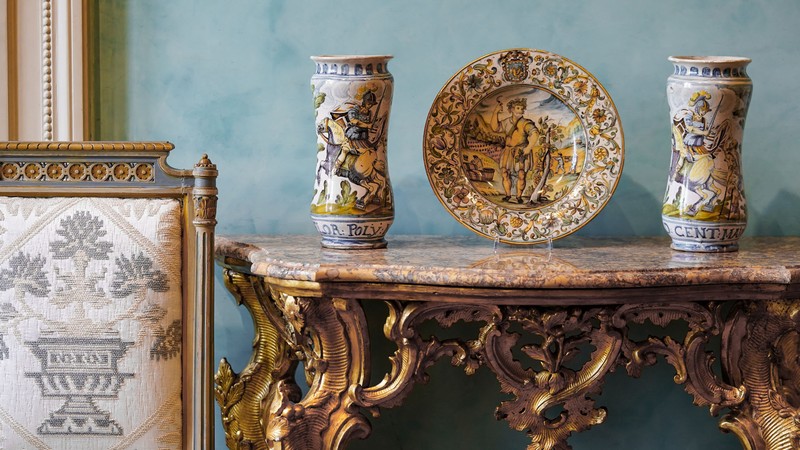
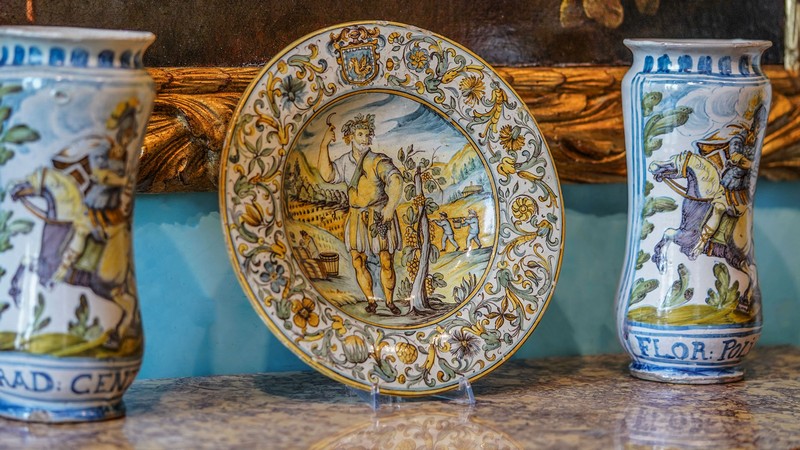
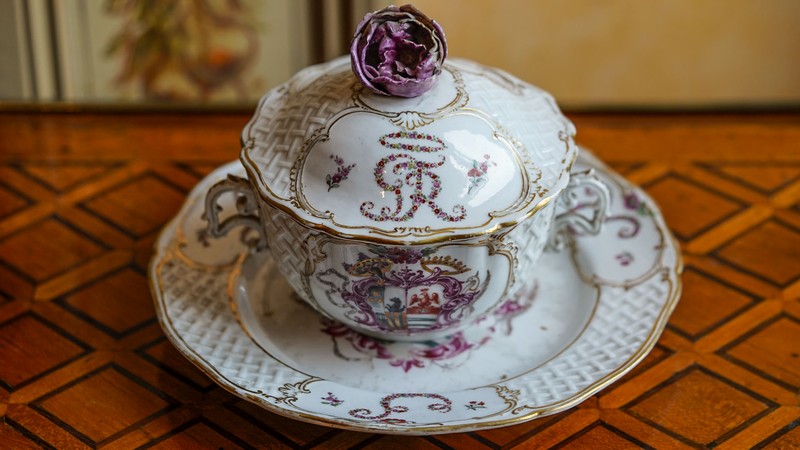
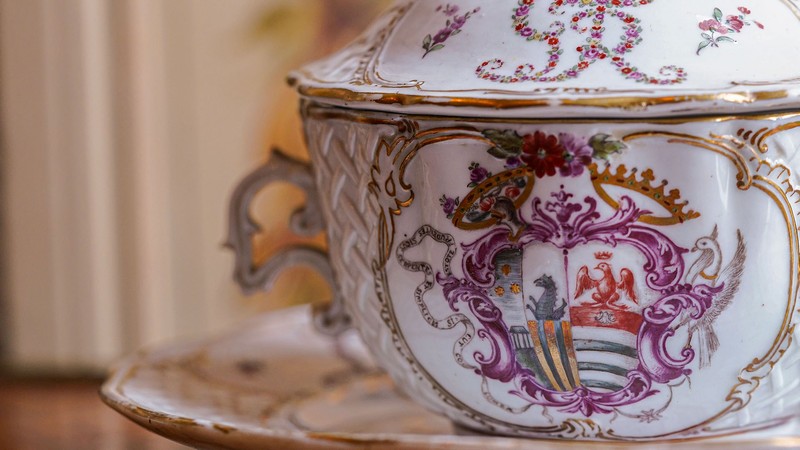
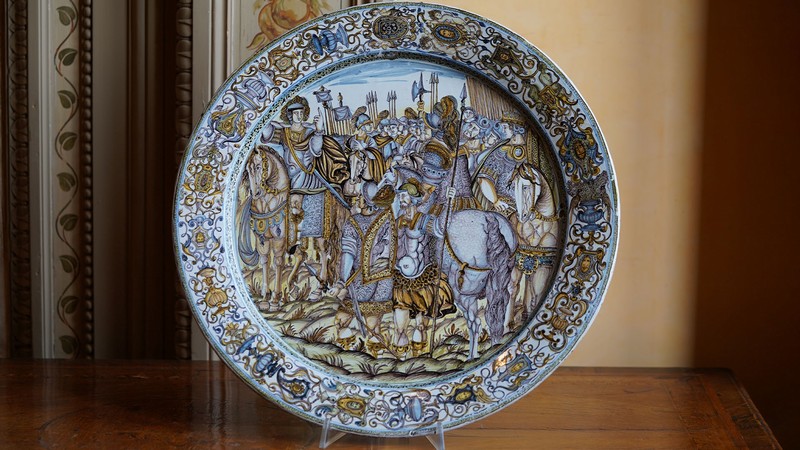
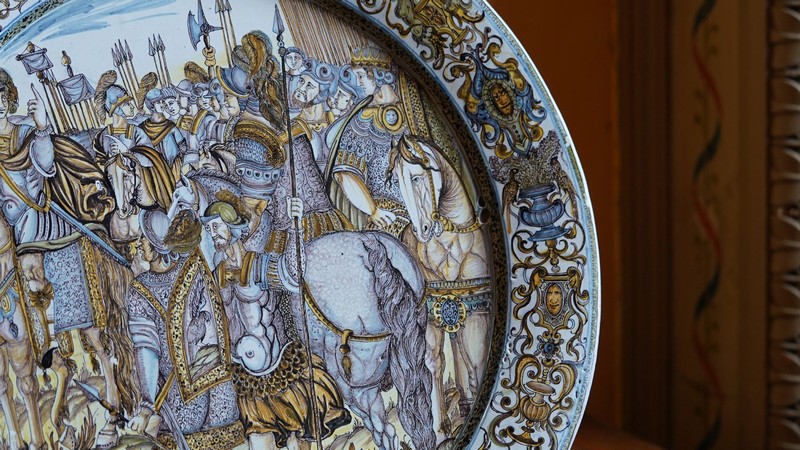
Cambi Auction House presents a new appointment dedicated to Majolica and Porcelain. A fine collection of finely decorated works, ranging from the very first porcelains of the 16th century to 20th-century production.
Among the lots in the auction worth mentioning is Lot 42, a large riser from Pavia, from the Imbres or Rampini Manufactory, dated the last quarter of the 17th to the early 18th century. The large riser, decorated in polychrome with a large fire, has a barely raised rim and rests on a wide annular foot. On the flat surface of the recto we find the entire repertoire of Pavia's artistic culture of the late 17th century, of which the painters of the Africa family were particularly virtuosic. The typical landscape, animated by wayfarers with sticks, features architectural ruins with arches, pillars, columns, plinths with sculptures, the large vase, the bare tree, the turreted city in the background at sunset. The verso hosts manganese foliate clumps executed with rapid brushstrokes
Another fine lot, lot 71, a large dish from Castelli, by Francesco Grue, 1640-1650. The parade plate is decorated in the large cavetto with the historiated scene "The Allocation of Scipio" taken from an engraving by Antonio Tempesta (1555-1630). The soldier from behind in the center carries a shield with the patron's coat of arms. Other plates with the same scene are known, all from the workshop of Francesco Grue, with the shield bearing the coat of arms of different lineages. On the exceptional brim, bordered by a double frame, a dense decoration of whorls sees ever-changing elements with naked figures, fantastic birds, harpies, shields with masks, and monumental vases that follow one another seamlessly.
Also of note is Lot 74, a pair of rare apothecary jars, also from Castelli, from the Pompei or Carlo Antonio Grue workshop, c. 1680-1690. On each small albarello the blue monochrome decoration sees, seamlessly, a landscape formed by small island clumps dominated by a large putto, on one sleeping accompanied by a wild horse, on the other intent on playing a fife in front of a rooster in an exotic landscape with palm trees and a lion intent on climbing a ladder. Also buildings and insects in flight. (See also lot 75).
Among the main lots is Lot 76, the small albarello from the Spezieria dell'Ospedale di San Giacomo degli Spagnoli in Naples, made in Castelli, Bottega dei Gentile, 1685-1700. The decoration features in the center the tripartite coat of arms of the Caracciolo-Orsini-Carafa families dominated by the double-headed eagle with marquis crown, surrounded by vines with jagged leaves ridden by two putti. Underneath is the apothecary inscription in capital letters "Pil.D.trib.cv.Rhabarbaro" The tripartite coat of arms is referred to the donation of the apothecary outfit by the three Neapolitan families (cf. G.Donatone, La maiolica napoletana del Seicento, Cava dei Tirreni 1984, table 19b). Of the same provenance is lot 77, an orciolo by Castelli, Bottega dei Gentile, last quarter of the 17th century. The lot is characterized by its ovoid body with high neck and tubular spout.
Lot 80, on the other hand, is a Castelli tile by Liborio Grue (1702-after 1776). The scene depicts the famous biblical episode of "Moses Saved from the Waters" painted in grand fire colors with an elegant pictorial formula: from the blue setting colored with green and yellow, and shaded in brown.
Also up for auction, lots 100, 101 and 102, five different eighteenth-century saplings from the apothecary's outfit of the Certosa di San Martino in Naples.
Of great value and elegance is the mezzina plate (lot 127), from Doccia, Manifattura Ginori, circa 1873. The season of the International Expositions in the second half of the 19th century saw assiduous participation by Manifattura Ginori, which in line with the taste of the moment introduced into its production majolica defined as "artistic," initially inspired by Renaissance achievements, as recognizable in the mezzina plate presented here. The raised shape of the dish suggests a basin in whose central ring, decorated with the effigy of a Renaissance man, the foot of the mezzina was inserted The subdivision into segments, defined by its sbaccellatura, is decorated with "raffaellesche," a name attributed to "grotesques" painted in ceramics on a white background. The mark with only the crown, lacking the inscription "Ginori," confirms, together with the model number "4" and the number "5" referring to the decoration, an early production of this specimen datable around 1873.
Also very rare is the vase with lid (lot 136) made on Isola Bella (Lake Maggiore), by the small Borromeo manufactory, c. 1924-1930. This vase echoes the forms of the eighteenth-century Savona vases with orchard-socket lids and is richly decorated in polychrome Raphaelesque patterns with a sure hand. It is quite rare to come across majolica from the "Ceramica d'Arte Isola Bella" manufacture of the Borromeos located on Isola Bella. In fact, the workshop was founded in 1923 with the arrival of a Tuscan master called by the Borromeos to practice in a small house on the island later called "the house of the Maiolicaro" The activity, however, lasted only a few years to cease in 1931.
Prominent in the catalog are the nucleus composed of eleven very rare porcelains from Vinovo, part of a private collection in Turin (lots 158 to 168), and a rare puerpera cup with underplate produced in Venice by the Manifattura Cozzi, toward the end of the 18th century. In particular, the puerpera cup possesses handles with rocailles scrolls and lid grip molded to a large foliate rosebud. The polychrome decoration sees on the cup and lid a reserve with the Teggia Droghi and Rangoni coat of arms departed in palo, which is repeated in the cavetto of the plate. In the opposing reserve is the monogram with the crossed letters "GTR" formed by garlands of small flowers. The rest of the surface is modeled as woven wicker. The "GTR" monogram reveals that the soup bowl belonged to Giulia Teggia Rangoni, who went on to marry Giuseppe Teggia Droghi in 1786. Since we know that the puerpera cup was the husband's gift to his wife for the birth of their first child, our porcelain is therefore to be dated after 1786. In 1785 Giuseppe Teggia Droghi and his brother Cristoforo were ascribed by Duke Ercole III d'Este to the nobility and patriciate of Modena. Giuseppe's descendants probably died out, and the puerpera cup passed to Cristoforo's descendants where it remains to this day.
Experts for the auction


![Coppia di “glacières” Francia, Parigi, probabilmente Manifattura Dihl & Guérhard, primi del XIX secol [..]](https://imageapi.cambiaste.com/api/lotto/immagine/277686/0/600.jpg)

![Una zuppierina, otto piatti, una zuccheriera e una tazza biansata Milano, Manifattura di Pasquale Rubati, [..]](https://imageapi.cambiaste.com/api/lotto/immagine/272636/0/600.jpg)


![Grande alzata Pavia, Manifattura Imbres o Rampini, ultimo quarto del XVII - inizi del XVIII secolo Decorazione [..]](https://imageapi.cambiaste.com/api/lotto/immagine/272444/0/600.jpg)



